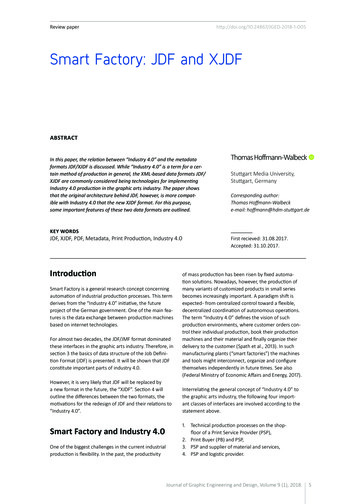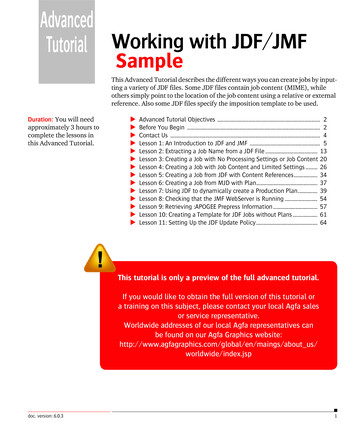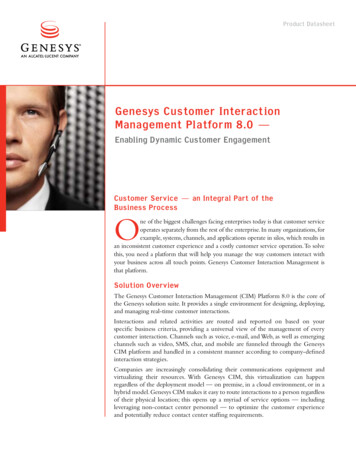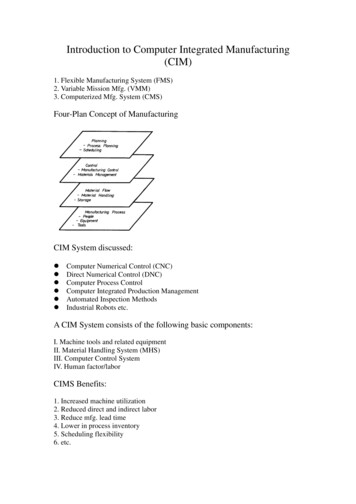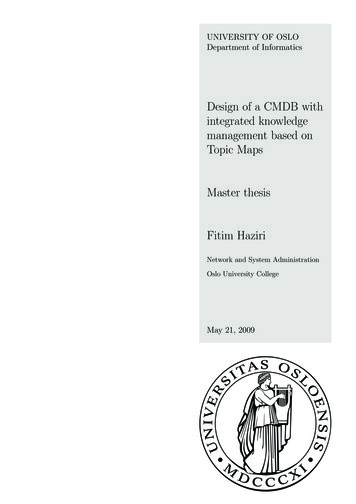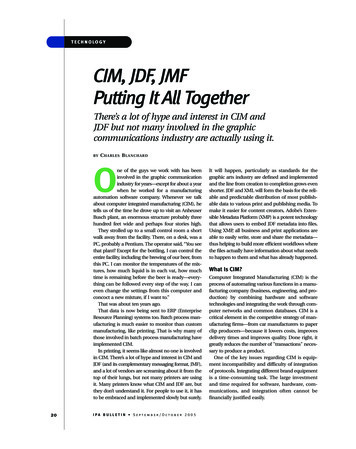
Transcription
20-25 rev 10/2110/21/054:50 PMPage 20T E C H N O LO G YCIM, JDF, JMFPutting It All TogetherThere’s a lot of hype and interest in CIM andJDF but not many involved in the graphiccommunications industry are actually using it.BYC HARLES B L ANCHARDOne of the guys we work with has beeninvolved in the graphic communicationindustry for years—except for about a yearwhen he worked for a manufacturingautomation software company. Whenever we talkabout computer integrated manufacturing (CIM), hetells us of the time he drove up to visit an AnheuserBusch plant, an enormous structure probably threehundred feet wide and perhaps four stories high.They strolled up to a small control room a shortwalk away from the facility. There, on a desk, was aPC, probably a Pentium. The operator said, “You seethat plant? Except for the bottling, I can control theentire facility, including the brewing of our beer, fromthis PC. I can monitor the temperatures of the mixtures, how much liquid is in each vat, how muchtime is remaining before the beer is ready—everything can be followed every step of the way. I caneven change the settings from this computer andconcoct a new mixture, if I want to.”That was about ten years ago.That data is now being sent to ERP (EnterpriseResource Planning) systems too. Batch process manufacturing is much easier to monitor than custommanufacturing, like printing. That is why many ofthose involved in batch process manufacturing haveimplemented CIM.In printing, it seems like almost no one is involvedin CIM. There’s a lot of hype and interest in CIM andJDF (and its complementary messaging format, JMF),and a lot of vendors are screaming about it from thetop of their lungs, but not many printers are usingit. Many printers know what CIM and JDF are, butthey don’t understand it. For people to use it, it hasto be embraced and implemented slowly but surely.20I PA B U L L E T I N S e p te m b e r / O c to b e r 2 0 0 5It will happen, particularly as standards for thegraphic arts industry are defined and implementedand the line from creation to completion grows evenshorter. JDF and XML will form the basis for the reliable and predictable distribution of most publishable data to various print and publishing media. Tomake it easier for content creators, Adobe’s Extensible Metadata Platform (XMP) is a potent technologythat allows users to embed JDF metadata into files.Using XMP, all business and print applications areable to easily write, store and share the metadata—thus helping to build more efficient workflows wherethe files actually have information about what needsto happen to them and what has already happened.What Is CIM?Computer Integrated Manufacturing (CIM) is theprocess of automating various functions in a manufacturing company (business, engineering, and production) by combining hardware and softwaretechnologies and integrating the work through computer networks and common databases. CIM is acritical element in the competitive strategy of manufacturing firms—from car manufacturers to paperclip producers—because it lowers costs, improvesdelivery times and improves quality. Done right, itgreatly reduces the number of "transactions" necessary to produce a product.One of the key issues regarding CIM is equipment incompatibility and difficulty of integrationof protocols. Integrating different brand equipmentis a time-consuming task. The large investmentand time required for software, hardware, communications, and integration often cannot befinancially justified easily.
20-25 rev 10/2110/21/054:51 PMPage 21One of the key issues regardingCIM is equipment incompatibilityand difficulty of integration ofprotocols. Software, hardware, andcommunications have to beintegrated to talk to one anotherfor CIM to become a reality.Computer integrated manufacturing is no cureall. It is an operational tool that, if implementedproperly, provides a new dimension to competing:quickly producing high quality products and delivering them with unprecedented lead times andswift decisions.The “language” to get us there is JDF.So What Is JDF Anyway?Just like any other industry, the printing and publishing industry has standard nomenclature thathas to be defined to help describe how certainprocesses are done.For printing, Job Description Format (JDF) is asystems-independent “language” to standardize theexchange of information between different graphiccommunication applications and systems andprocesses. It is not a data format itself. It is really a“metadata” format (data about data or processesdescribing the form, function, intent and processof the actual file data). JDF is really a standard forany digital file, describing every possible specification required to produce any type of print job.Exact job specifications can be tailored to the typeof work—for example, the number of pages, colorand ink settings, binding type, deadlines, and evenshipping instructions. JDF also defines all theprocesses and resources needed to complete a project, and allows everyone, wherever they are, to seeits status in real time, at any production stage.To assure it is as open as possible, JDF is governed by the International Cooperation for theIntegration of Processes in Prepress, Press and Postpress (CIP4), and is written in XML (eXtensibleMarkup Language), a simple yet versatile fileformat. XML was chosen as the basis for JDFbecause it is already being used in publishing, editorial and catalog printing.With JDF the hope is that we finally have a universal standard for content creators, prepress service providers, printers and postpress services(including binderies and finishers), enablingeveryone to communicate and transmit details of aprint job through digital workflows from creationto completion. This has been somewhat possiblefor a number of years by some workflow companies who have used open database, communications and protocol standards. But the differencewith JDF is that now everyone will use the samestandard set of descriptions, implementing aprocess that is totally independent of application,system, platform, or even language.S e p tem b e r / O c to b e r 2 0 0 5 I PA B U L L E T I N21
20-25 rev 10/2110/21/054:51 PMPage 22T E C H N O LO G YThen, What Is JMF?As we all know, a workflow system is a dynamic setof interacting processes, devices and MIS systemsworking on a job. For the workflow to run efficiently, these processes and devices must communicate and interact in a well-defined manner.Ultimately, in a perfect system, the MIS systemoversees everything about a workflow. However, itneeds a way to connect to the entireworkflow and understand what’sgoing on—in real time. This is theWhat Will JDF & CIM Do?reason for the Job Messaging FormatJDF and CIM promise to give you the(JMF), a messaging system for JDFtools to deliver faster and higherinformation. It helps send informaquality services and more accuratetion between MIS and production sysproduction feedback in real time.tems. The format provides for aWhile a job is being processed, anumber of different types of mescontinual stream of job metadatasages, from simple notification tocan be fed into costing, billing andother devices to queries and toMIS systems. They not only deliverrequests of other devices. JMF is agreater accuracy in cost and estimatedetermination by connecting prolow level communication system.duction and management systemsThink of it like you think of TCP/IP fortogether but also result in a muchyour computer network.more efficient and effective use ofJMF helps production workflowavailable resources. And, you’ll behardwareand software systems in aable to choose equipment purelyJDFworkflowcommunicate withbased on technical and/or commercialadministrativecomponentsand systemmerits, rather than wonderingwhether it will work with your system.controllers. It helps exchange dynamicIn the end, you’ll benefit from beingdata in real time, such as informationable to do more work with the samefrom various production devices, statusamount of equipment.messages and queue management, bysending direct commands to and fromdifferent devices.The sending machine (or computer) is configured to understand thereceiving machine. They use an httpquery to communicate. Each deviceregisters itself, with an IP address onthe server system, as a JDF receiver.Information then travels from one device throughthe server to the other device, via JMF, to get up todate information.For example, one device can say, “I’m a laserprinter. Whenever you’re ready, feel free to send meJDF job parameters for my RIP. I’ll be happy to sendyou back information about the status of the jobfrom my end, via JMF, as I complete it.”By doing so, system components can collect performance data for each piece of equipment. If thisjob-tracking data is sent to an MIS system, it can be22I PA B U L L E T I N S e p te m b e r / O c to b e r 2 0 0 5sent to a job-tracking system to assess how a job isprogressing. After the fact, information about a completed job can be sent to an accounting system tocost out the job.The High-Level Vision for JDF and CIMThe vision for JDF and CIM is a total productionworkflow solution for the graphic communicationindustry that embraces every facet of production—a solution where businesses can deliver faster andhigher quality services, more accurate productionfeedback in real-time, and one that ensures applications and systems—even from different manufacturers—can seamlessly interact with one another.The hope is that JDF pushes the industry towardsCIM, applying manufacturing parameters—andbest practices—to production. JDF will help production professionals to take out the “blur” fromthe production process. While a job is beingprocessed, a continual data stream of job metadatais fed into costing, billing and MIS systems. Prepressproduction systems will poll and work intimatelywith production databases, reporting on how muchtime each portion of a job took. The individual production status of job elements, pages and proofswill be automatically tracked within the entire workflow. Statistical analyses can be triggered from theclick of a mouse to determine profitability per job,customer or cost center.But with CIM you don’t have to think locally.Describing a job in JDF can be even more helpfulshould a job leave your plant. For example, imagineif a plant in Hong Kong has to print the same magazine that you have just printed in the States. JDFallows you to describe the job in “print Esperanto”—a universal language everyone can understand.What Will JDF and CIM Do for Me?You may well have a great communication andreporting system that trickles down from the originator all the way to the newsstand. “Do this, thendo that, and (with fingers crossed) you may wellhave something printed.” However, it would behelpful to have a reporting system that is bidirectional. For example, if the platesetter autoloaderwere no longer “auto,” it would be great if those inthe plating/prepress department receive a warning.And, if fixing the problem causes a delay, it wouldbe helpful for your customer to automaticallyreceive an alert that the job may be a bit late. (Then
20-25 rev 10/2110/21/054:51 PMPage 23again, maybe it wouldn’t.) Getting everyone on thesame page is why a JDF-based production systemcan be invaluable. And if there is sensitive information that you don’t want to share, with everyone (forexample, your customer) that can be set up as well.So, what can JDF do? Right now, many departments have to re-enter the same details when a jobenters their own systems. This creates opportunities for error, along with adding a significantamount of unnecessary tasks. Using JDF, this production fragmentation becomes minimized and theprocess becomes more streamlined. Once a jobrequest is received and the job accepted, the JDFfile is passed on to the workflow system where jobinstructions are carried out. At every stage, onesystem talks to another to determine if it can handlea particular part of the job. At the same time eachsystem can keep all the other systems updated withthe job’s production status, even linking into MIStype systems as necessary. And, everyone concernedcan see its status—wherever they are—at any production stage.Perhaps you outsource a portion of a job. What ifyou print the body of a book in-house, but someoneelse prints the cover? Eventually, it all has to cometogether at the bindery. When you outsource yourjob, you want to be assured that the subcontractor’sproduction department understands this. JDFpromises that this will happen (or if it doesn’t, thateveryone knows about it).JDF and CIM promise to give you the tools todeliver faster and higher quality services and moreaccurate production feedback in real time. While ajob is being processed, a continual stream of jobmetadata can be fed into costing, billing and MISsystems. They not only deliver greater accuracy incost and estimate determination by connectingproduction and management systems together—but also result in more efficient and effective useof available resources. And, you will be able tochoose equipment purely based on technicaland/or commercial merits, rather than wonderingwhether it will work with your system.In the end, you will benefit from being able to domore work with the same amount of equipment.What Won’t JDF and CIM Do for Me?A quick note here: JDF and CIM help create a systemfor print production that helps streamline the production. They will not fix your plant and make it effi-cient on their own. Part of the process of implementing JDF requires that you know how your plantsystematically produces graphic materials and thatyou have a defined workflow system in place. JDFand CIM will then allow you to connect your different workflow systems along with the business sys-The vision for JDF and CIM is a totalproduction workflow solution for thegraphic communication industry thatembraces every facet of production.tems. Then you will be able to automate productionthroughout the supply chain and to generate realtime reporting on what the workflow has done toyour files, how much the job costs you, or how muchyou can bill the customer. If you cannot define iteasily, no computerized system will help. In fact, it islikely you won’t even be able to install a reportingsystem. You won’t know what to report. If you havean organized approach to production, the automation and reporting that comes from CIM will makeyou more efficient and point out deficiencies forimprovement. That’s the final reward from CIM. And,in this world of tight margins, it can be the differencebetween life and death.The RealityThe reality is that much of what JDF promises canbe done today without JDF. Many workflows useopen databases and poll them, pulling and sendinginformation. However, today there isn’t one systemthat can talk throughout the entire workflow usingthe same original data, because different vendors’boxes can’t talk to each other. JDF allows systemsfrom various manufacturers to read and understand data in the same way.Simply connecting stages within printing workflows is one thing. Actually making them understand what they have to do in their own languageis something quite different. While every industrymanufacturer seems to be promoting how theirsystems are “fully JDF compliant,” don’t take it asgospel. True JDF “implementation” is caughtbetween a rock and a hard place. Potential usersS e p tem b e r / O c to b e r 2 0 0 5 I PA B U L L E T I N23
20-25 rev 10/2110/21/054:51 PMPage 24T E C H N O LO G YSuggestions to Approaching JDFAlthough JDF is still in its infancy, graphic solutionsproviders need to begin preparing for it now.kTake a hard look at your operation. Identify andschematize your workflows and find a common fit. Huntdown all the production parameters. Gather job ticketinformation in all the manufacturing parameters.kNormalizing that data is the key to success. It is thepreliminary information that is important. Don’t flood the jobticket with parameters that won’t be used. Get only theinformation you need from your customers. By limiting themanufacturing parameters to the bare minimum of entries andvariables, you are reducing the possibility to create an error.kStart with one piece of the process—for example,imposition. Begin by identifying, documenting, andevaluating the results. Start small, working in a laboratorylike environment. Then bring the JDF lab solution to the realproduction. If the solution works there, take it a stepfurther to ensure it works everywhere. Once you haveperfected that piece, go to the next.are waiting for a JDF-enabled system (whetherthey’re in the position to buy everything is a different matter), and manufacturers are waiting fordemand before offering such a system.When JDF and JMF integrate a complete fullprocess, then it becomes true CIM. Talk all you want,but until binders and palletizers and presses and assetmanagement systems and all other hardware andsoftware work together, it is not a complete system.With everything that’s been touted about JDF, thefact is that although the implementation of JDFenabled communications can be prepared for you(to some degree), the system is still up to you. It canbe anything you want it to be. Although in theory theJDF file is created when the job is drafted and itsspecifications are entered into a JDF-capablesystem—perhaps directly into a printer’s management information system—in practice, the JDF filecould be created at any stage of the chain.When you think about it, there are still islands ofintegration in printing, even as systems have becomemore automated. There still isn’t a single controlpoint—from the photographer or editor to pageassemblers to artists to publishers to in-house corporate marketing departments; from prepress toprinting to binding to fulfillment to mailing, shippingand delivery. JDF allows you to bridge all islands to24I PA B U L L E T I N S e p te m b e r / O c to b e r 2 0 0 5form one large integrated system. Then—and onlythen—it becomes a virtual CIM.The islands don’t talk within themselves, but are allprocesses that communicate from a single point. Thecontent originator owns a content managementsystem that will manage the use of content—and communicate via JDF. The print production system willcreate a job ticket and estimate a job—and communicate via JDF. The prepress workflow will take a fileand prepare it for output—and communicate via JDF.The press and finishing departments both have systems to oversee their operations—and communicatevia JDF and so on through fulfillment and shipping.To the end user, the sum is more valuable than theparts. When you can tie all the islands, linking all ofthe hardware and software together and define theentire process of CIM, JDF is the language allowingyou to combine the pieces and provide a larger,higher level view of projects from start to finish.So with the models becoming distribute and printrather than print and distribute, who ultimately ownsthe controlling MIS interest? It could reside in theERP systems of the content originator, like SAP orPeoplesoft. More and more, companies are movingto ERP solutions to manage print processes whenbefore they were not.What Am I Supposed to Do with JDF and CIM?The good news is that most of the communicationswork is being done by vendors. If you buy JDFenabled hardware and software, that’s half thebattle. And, many vendors are happy to offer yousoftware or upgrades to your existing equipment.Since JDF-enabled devices communicate directly,little to no user intervention is required. In fact,many participants of a JDF-enabled productionsystem may not even know that the system utilizesJDF at all.But remember: JDF is not a specific process, butrather a set of reporting rules that help you definehow your prepress department works. You have tospend the time understanding how work flowsthrough your operation before JDF implementationcan help. Until you have a grasp of how your plantworks, CIM and JDF are useless.With that in mind, here are some suggestions tohelp approach JDF: Take a hard look at your operation. Identify andschematize your workflows and find a common fit.JDF is forcing companies to look at production
20-25 rev 10/2110/21/054:51 PMPage 25,3 :RUNIORZ 7( GHD'HVLJQ&RQFHSW3UH IOLJKW,PDJH VVHPEO\ /D\RXW3UH IOLJKW3URRIFRQWHQW OD\RXW7UDSSLQJ &RORU %UHDNV&RORU GLJLWDO0DQDJH IRU 2XWSXW)LQDO 5,3&RQWUDFW3URRI3ODWLQJ&RQWUDFW DUG3URRI)LQDO 5,3&RPSXWHU 7R VWULEXWLRQ6WHSSLQJ VVHW0DQDJHPHQW,QWHUQHW 'DWD&DSWXUH&RORU &RUUHFWLRQ3KRWR JUDSK\,PDJHU\ 'HILQHG RU&UHDWHGQHJDWLYHV'DWD%DVH0JPWGLJLWDO SKRWR&RPSXWHU 7R 3ODWH)LQDO 5,3/DUJH DO 3UHVV5HWRXFKLQJ6FDQQLQJ,QWHUQHW3XEOLVKHG5DZ &RORU 3URRILQJ UWZRUN7H[W &RS\&UHDWLRQ7\SRJUDSK\0HGLD9DULDEOH'DWD&RS\ULJKW ,3 7KH VVRFLDWLRQ RI *UDSKLF 6ROXWLRQV 3URYLGHUVPart of the process of implementing JDF requires that you know how your plant systematically produces graphic materials and that you have a definedworkflow system in place. To help companies define their workflow systems, IPA’s Workflow TEAM has developed this graphic workflow process.more scientifically and procedurally. Hunt down allthe production parameters. For example: producing a catalog, you need to know how it isprinted, bound, the CTP equipment, preferred fileformat, whether or not the files need to be trapped,what resolution, what color space, and so on. Youhave to gather job ticket information and all themanufacturing parameters. Normalizing that data is the key to success. It’sthe preliminary information that’s important. Don’tworry about extraneous stuff in the beginning.Don’t flood the job ticket with parameters thatwon’t be used. Get only the information you needfrom your customers. Factual discipline is what’simportant. By limiting the manufacturing parameters to the bare minimum of entries and variables,you’re reducing the possibility to create an error. Start with one piece of the process—for example,imposition. Begin by identifying, documenting, andevaluating the results. Start small, working in a laboratory-like environment. Then, bring the JDF labsolution to the real production. If the solution worksthere, take it a step further to ensure it not only worksfor you, but everywhere. It would probably help toinvolve your suppliers and partners in this. Once youhave perfected that piece, go to the next.JDF is still in its infancy. At tradeshows you cansee a number of implementations of pieces thatwork very well but might not have been tested in afull-fledged production environment. But the technology and process is maturing quickly. Don’t fallinto the trap of listening to vendors who say whatJDF “will be” (perhaps even this article). The systems integration is happening today in companieslarge and small.Get the facts, get the specs, and get your facility inorder. Start knocking down the JDF barriers, one stepat a time. Start getting your partners—the otherislands—in step. Then, perhaps, sometime in thefuture, you’ll be able to look at your computer, pointto a group, and tell them, “I can control the entireproduction process from this one computer.”S e p tem b e r / O c to b e r 2 0 0 5 I PA B U L L E T I N25
higher quality services, more accurate production feedback in real-time, and one that ensures appli-cations and systems—even from different manu-facturers—can seamlessly interact with one another. The hope is that JDF pushes the industry towards CIM, applying manufacturing parameters—and best practices—to production. JDF will help pro-
